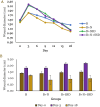Wound healing effect of nutmeg (Myristica fragrans) cream on second-degree burn in animal model
- PMID: 38798873
- PMCID: PMC11125405
- DOI: 10.52225/narra.v4i1.621
Wound healing effect of nutmeg (Myristica fragrans) cream on second-degree burn in animal model
Abstract
Second-degree burn, the most common among burn degrees, underscores the importance of timely and proper treatment in influencing prognosis. Nutmeg (Myristica fragrans), renowned for its potent antibacterial and antifungal properties, also serves as an effective antiseptic for open wounds. The aim of this study was to identify the phytochemical constituents of nutmeg essential oil and analyze the wound healing effect of nutmeg cream on second-degree burns in an animal model. An experimental study with a completed randomized design was conducted on Rattus norvegicus strain Wistar rats with second-degree burn. This study had four groups and each group consisting of four rats: B (burn-treated base cream), B+N (burn-treated 3% nutmeg cream), B+SSD (burn-treated silver sulfadiazine (BSS)), and B+N+SSD (burn-treated 3% nutmeg cream and SSD in a 1:1 ratio). The phytochemical analysis of nutmeg essential oil was conducted by gas chromatography and mass spectroscopy (GC-MS). The burn diameter and burn wound healing percentage were measured from day 0 to 18. One-way ANOVA followed by post hoc analysis using the least significant difference (LSD) was employed to analysis the effect. The phytochemical analysis of nutmeg essential oil found that myristicin, terpinene-4-ol, terpinene, safrole and terpinolene were the most abundant putative compounds in nutmeg essential oil. On day 0, the average burn wound diameters were 1.4 cm in all groups and increases were observed in all groups on day 3. The wound diameter decreased until day 18 with the smallest burn wound diameter was found in the B+N group (0.86±0.37 cm), followed by B+SSD (0.93±0.29 cm). The B+SSD group exhibited the highest percentage of burn wound healing (56.80±14.05%), which was significantly different from the base cream (p<0.05). The percentage of burn wound healing in rats given 3% nutmeg cream was 41.88±13.81%, suggesting that nutmeg cream could promote burn wound healing in rats induced by second-degree burns.
Keywords: Burn; Myristica fragrans; nutmeg; second-degree burn; wound healing.
© 2024 by the authors.
Conflict of interest statement
All the authors declare that there are no conflicts of interest.
Figures






Similar articles
-
Comparison of topical sucralfate and silver sulfadiazine cream in second degree burns in rats.Adv Clin Exp Med. 2013 Jul-Aug;22(4):481-7. Adv Clin Exp Med. 2013. PMID: 23986207
-
Crocodile oil enhances cutaneous burn wound healing and reduces scar formation in rats.Acad Emerg Med. 2012 Mar;19(3):265-73. doi: 10.1111/j.1553-2712.2012.01300.x. Acad Emerg Med. 2012. PMID: 22435858
-
Comparison of purified olive oil and silver sulfadiazine in the treatment of partial thickness porcine burns.Am J Emerg Med. 2012 Jan;30(1):79-83. doi: 10.1016/j.ajem.2010.10.003. Epub 2010 Dec 14. Am J Emerg Med. 2012. PMID: 21159471
-
Wound healing in second-degree burns in rats treated with silver sulfadiazine: a systematic review and meta-analysis.J Wound Care. 2022 Apr 1;31(Sup4):S31-S45. doi: 10.12968/jowc.2022.31.Sup4.S31. J Wound Care. 2022. PMID: 35404714
-
Nutmeg (Myristica fragrans Houtt.) essential oil: A review on its composition, biological, and pharmacological activities.Phytother Res. 2022 Jul;36(7):2839-2851. doi: 10.1002/ptr.7491. Epub 2022 May 13. Phytother Res. 2022. PMID: 35567294 Free PMC article. Review.
Cited by
-
Could fasciotomy prevent amputation in patients with electrical burn injuries? Insights from a cross-sectional study in Indonesia.Narra J. 2024 Aug;4(2):e834. doi: 10.52225/narra.v4i2.834. Epub 2024 Aug 15. Narra J. 2024. PMID: 39280300 Free PMC article.
References
-
- Evers LH, Bhavsar D, Mailänder P.. The biology of burn injury. Exp Dermatol 2010;19:777–783. - PubMed
-
- Ertaş B, Okuyan B, şen A, et al. . The effect of Cotinus coggygria L. ethanol extract in the treatment of burn wounds. J Res Pharm 2022;26:554–564.
Publication types
MeSH terms
Substances
LinkOut - more resources
Full Text Sources
Medical
Miscellaneous
